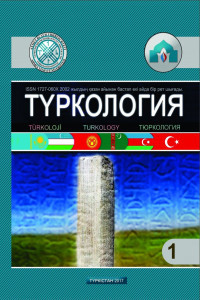DİNİ SORUNLAR VE TÜRK YAZILI EDEBİYATI
"Oltun Yorig" ("Altın Işık") Avesta ile ilgili IX-X yüzyıllarda Türk halklarının edebi ve kültürel ortamında önemli bir rol oynar. "Oltun Yorig" başlıklı yazılı anıtı mitolojik görüntüleri Zeruana ve Horus ile Avesta anlam ve görüntülerin fonksiyonu hakkında soru işaretleri oluştudu. Yine de, Zerdüştlük ve Budist öğretileri arasındaki uyum, makalede iyi bilinmektedir. Haliç'in tüm tanrıları, efendileri, yardımcı ruhları kendi görevlerine sahiptir. Ancak, Tanrı'nın tüm Tanrılar arasında Yüce Varlık Örneğin Oltun Yorigle ilgili bir yasa iletebilen (yani Buda Khan) tanrıça özü, gerçek rakam olduğu açıktır. "Altın Işık" da ismin Kavsikiya adını nasıl gördüğü ile ilgili görüş ve görüşler vardır. "Altın Işık" da yazarın Avesto'nun mitolojik görüntülerinin nasıl ortaya çıktığıyla ilgili gözlemlerini içerir. "Altın Işık"nin mitolojisinde ikili uzay onu ikinci isim İndra doğumundan sonra başladı gerçeğine odaklanıyor. İndran'ın ana görevi mitolojik dünyadan gerçek bir dünya yaratmaktır. İndra dünyaya karanlığı ve ışığı, gece ve gündüz, hayat ve ölüm, ve ikinci kozmogoni sahne verir. Rigvedada bu gerçekler, mitolojiye dayanan, Avesta ve Rigveda’ya dayalı mitoloji ve mitoloji Avesta, yazar ileriye koyar.
RELIGIOUS MOVEMENTS AND TURKIC WRITTEN LITERATURE
This article speaks about literary work “Oltin Yorug” (The Golden Light) which plays very important role in cultural and literary environment of Turkic people in IX-Xth centuries. The author of the article speaks about relation of this workmenship and “Avesto”. He investigates commonality of meaning and function of mythological images of Zervan and Khormuzd from “Golden light” and images of “Avesto”. The harmony between Zoroastrian and Buddhist doctrines found its reflection in the article. All the gods, the masters, helping spirits in “Golden Light” have their own responsibilities, among all of them only Khormuzd has the right to bring true and legitimate law to the God of gods, which is the khan of Buddha. Khormuzd is the main hero of “Golden Light”. Author shares with us about his opinion of how Khormuzd’s name Kavsikia came about, how mythological images of “Avesto” found their reflection in “Golden Light”. The article focuses on the fact that the dualistic space started in mythology of “Golden Light” after the birth of Khormuzd’s second name Indra. Indra’s main task was to create a real world out of mythological one. Indra brought into the world darkness and light, day and night, life and death. The second cosmogony stage is clearly shown especially in “Rigveda” the Veda’s connected with Indra. Taking this and other facts into account we can say that ancient Indian mythology and “Avesto” are connected, both of them began with the emerge of Vedas, the dualistic vies started with the birth of Khurmusd and Akhriman. Finally, image of Indra was the basis for all of these.
___
- Олтун ёруғ. 1-китоб. «Фан», 2009, 248 б.
- Олтун ёруғ. 2-китоб. «Мumtoz Soz», 2013, 326 б.
